蒋悟生《生物专业英语》教学案
- 格式:doc
- 大小:259.00 KB
- 文档页数:43
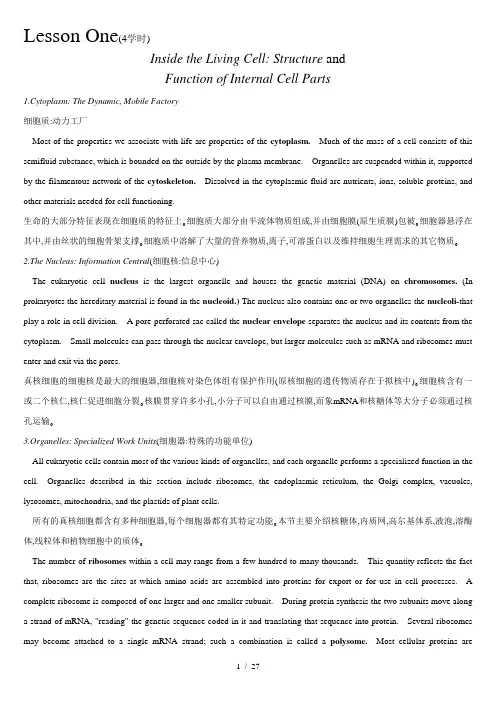
Lesson One(4学时)Inside the Living Cell: Structure andFunction of Internal Cell Parts1.Cytoplasm: The Dynamic, Mobile Factory细胞质:动力工厂Most of the properties we associate with life are properties of the cytoplasm. Much of the mass of a cell consists of this semifluid substance, which is bounded on the outside by the plasma membrane. Organelles are suspended within it, supported by the filamentous network of the cytoskeleton. Dissolved in the cytoplasmic fluid are nutrients, ions, soluble proteins, and other materials needed for cell functioning.生命的大部分特征表现在细胞质的特征上。细胞质大部分由半流体物质组成,并由细胞膜(原生质膜)包被。细胞器悬浮在其中,并由丝状的细胞骨架支撑。细胞质中溶解了大量的营养物质,离子,可溶蛋白以及维持细胞生理需求的其它物质。2.The Nucleus: Information Central(细胞核:信息中心)The eukaryotic cell nucleus is the largest organelle and houses the genetic material (DNA) on chromosomes. (In prokaryotes the hereditary material is found in the nucleoid.) The nucleus also contains one or two organelles-the nucleoli-that play a role in cell division. A pore-perforated sac called the nuclear envelope separates the nucleus and its contents from the cytoplasm. Small molecules can pass through the nuclear envelope, but larger molecules such as mRNA and ribosomes must enter and exit via the pores.真核细胞的细胞核是最大的细胞器,细胞核对染色体组有保护作用(原核细胞的遗传物质存在于拟核中)。细胞核含有一或二个核仁,核仁促进细胞分裂。核膜贯穿许多小孔,小分子可以自由通过核膜,而象mRNA和核糖体等大分子必须通过核孔运输。anelles: Specialized Work Units(细胞器:特殊的功能单位)All eukaryotic cells contain most of the various kinds of organelles, and each organelle performs a specialized function in the cell. Organelles described in this section include ribosomes, the endoplasmic reticulum, the Golgi complex, vacuoles, lysosomes, mitochondria, and the plastids of plant cells.所有的真核细胞都含有多种细胞器,每个细胞器都有其特定功能。本节主要介绍核糖体,内质网,高尔基体系,液泡,溶酶体,线粒体和植物细胞中的质体。The number of ribosomes within a cell may range from a few hundred to many thousands. This quantity reflects the fact that, ribosomes are the sites at which amino acids are assembled into proteins for export or for use in cell processes. A complete ribosome is composed of one larger and one smaller subunit. During protein synthesis the two subunits move along a strand of mRNA, "reading" the genetic sequence coded in it and translating that sequence into protein. Several ribosomes may become attached to a single mRNA strand; such a combination is called a polysome. Most cellular proteins aremanufactured on ribosomes in the cytoplasm. Exportable proteins and membrane proteins are usually made in association with the endoplasmic reticulum.核糖体的数量变化从几百到几千,核糖体是氨基酸组装成蛋白质的重要场所。完整的核糖体由大亚基和小亚基组成。核糖体沿着mRNA移动并阅读遗传密码,翻译成蛋白质。一条mRNA上可能有多个核糖体,称多聚核糖体。大多数细胞蛋白是由细胞质中核糖体生产。输出蛋白和膜蛋白通常与内质网有关。The endoplasmic reticulum, a lacy array of membranous sacs, tubules, and vesicles, may be either rough (RER) or smooth (SER). Both types play roles in the synthesis and transport of proteins. The RER, which is studded with polysomes, also seems to be the source of the nuclear envelope after a cell divides.内质网,带有花边的生物囊,有管状,泡状之分,以及光滑和粗糙面区别。两种都与蛋白质的合成和运输有关。粗糙内质网上分布许多核糖体,也可能提供细胞分裂后所需的细胞膜。SER lacks polysomes; it is active in the synthesis of fats and steroids and in the oxidation of toxic substances in the cell. Both types of endoplasmic reticulum serve as compartments within the cell where specific products can be isolated and subsequently shunted to particular areas in or outside the cell.光滑内质网上无核糖体,主要作用是脂肪和类固醇的合成以及细胞内有毒物质的氧化。两种内质网合成的产物在其中进行分流或运输到细胞外。Transport vesicles may carry exportable molecules from the endoplasmic reticulum to another membranous organelle, the Golgi complex. Within the Golgi complex molecules are modified and packaged for export out of the cell or for delivery else where in the cytoplasm.运输小泡能够将可运输分子从内质网运输到高尔基复合体上。在高尔基复合体中修饰,包装后输出细胞或传递到细胞质中的其他场所。Vacuoles in cells appear to be hollow sacs but are actually filled with fluid and soluble molecules. The most prominent vacuoles appear in plant cells and serve as water reservoirs and storage sites for sugars and other molecules. Vacuoles in animal cells carry out phagocytosis (the intake of particulate matter) and pinocytosis (vacuolar drinking).细胞中的液泡好象是中空的,但实际上充满了液体和可溶分子。最典型的液泡存在于植物细胞中,储备水,糖以及其它分子。动物中的液泡起吞噬和胞饮作用。A subset of vacuoles are the organelles known as lysosomes, which contain digestive enzymes (packaged in lysosomes in the Golgi complex) that can break down most biological macromolecules. They act to digest food particles and to degrade damaged cell parts.溶酶体是液泡亚单位,含有消化酶,降解大部分生物大分子。消化食物微粒和降解损伤的细胞残片。Mitochondria are the sites of energy-yielding chemical reactions in all cells. In addition, plant cells contain plastids that utilize light energy to manufacture carbohydrates in the process of photosynthesis. It is on the large surface area provided bythe inner cristae of mitochondria that ATP-generating enzymes are located. Mitochondria are self-replicating, and probably they are the evolutionary descendants of what were once free-living prokaryotes.线粒体是细胞中化学产能的场所。另外,植物细胞中的质体在光合作用中利用光能产生碳水化合物,线粒体内嵴上提供了很大的表面积并分布着产ATP酶。线粒体自我复制,并且可能是自由生活的原核生物在进化中形成的后代。There are two types of plastids: leucoplasts, which lack pigments and serve as storage sites for starch, proteins, and oils; and chromoplasts, which contain pigments. The most important chromoplasts are chloroplasts-organelles that contain the chlorophyll used in photosynthesis. The internal structure of chloroplasts includes stacks of membranes called grana, which are embedded in a matrix called the stroma.质体有两种类型:白色体,缺乏色素,是淀粉,蛋白质和油的储备场所;色质体,含有色素。叶绿体是最重要的色质体,含有与光合作用有关的叶绿素。叶绿体的内部结构是由多层膜形成的叶绿体基粒,其中包埋在基质中的基粒称子座。4.The Cytoskeleton(细胞骨架)All eukaryotic cells have a cytoskeleton, which is a convoluted latticework of filaments and tubules that appears to fill all available space in the cell and provides support for various other organelles. A large portion of the cytoskeleton consists of threadlike microfilaments composed mainly of the contractile protein actin. They are involved in many types of intracellular movements in plant and animal cells. A second protein, myosin, is involve in the contraction of muscle cells. Another main structural component of the cytoskeleton consists of microtubules, which are composed of the globular protein tubulin and together act as scaffolding that provides a stable cell shape. Cytoskeletal intermediate filaments appear to impart tensile strength to the cell cytoplasm. Mechanoenzymes such as myosin, dynein, and kinesin interact with the cytoskeletal filaments and tubules to generate forces that cause movements.所有的细胞都有细胞骨架,网络结构的纤丝充满了它所能触及的全部空间并且对细胞器提供支持作用。细胞骨架大部分由微丝组成,微丝主要由可收缩的肌动蛋白组成。动植物细胞的许多种类型细胞内运动与肌动蛋白有关。第二类蛋白是肌球蛋白,它与肌肉细胞的收缩有关。细胞骨架的另一个主要结构成分是微管,由球状的微管蛋白组成,象脚手架一般维持细胞的稳定形态。细胞骨架的中间丝提供了细胞质伸缩动力。机械酶,例如,肌球蛋白,动力蛋白,驱动蛋白与微丝,微管相互作用产生动力而引起细胞运动。5.Cellular Movements(细胞运动Although the cytoskeleton provides some stability稳固to cells, its microtubules英[ˌmaikrəuˈtju:bju:l]and filaments 丝状物and their associated proteins enable cells to move by creeping 爬行or gliding 滑动. Such movements require a solid固体的substrate to which the cell can adhere附着and can be guided by the geometry dʒiˈɔmitri]几何形状of the surface. Some cells also exhibit [iɡˈzibit]展览chemotaxis, keməˈtæksis趋药性the ability to move toward or away from the source of a diffusing 扩散chemical.尽管细胞骨架提供了细胞的某些稳定性,微丝,微管及相关蛋白能使细胞爬行或滑动。这种运动需要固体基质依托并通过表面几何形状的改变而运动。某些细胞具备趋药性,即趋向或逃离扩散开的化学源。Certain eukaryotic cells can swim freely in liquid environments, propelled by whiplike cilia [ˈsiliə]纤毛or flagella英[fləˈdʒelə鞭毛. Both cilia and flagella have the same internal structure: nine doublets (pairs of microtubules) are arranged in a ring and extend the length of the cilium or flagellum, and two more microtubules run down the center of the ring. Every cilium or flagellum grows only from the cell surface where a basal body基体is located. Movement is based on the activities of tiny dynein动力蛋白side arms that extend from one of the microtubules of each doublet成对的东西.某些真核细胞能在液体液体中自由运动,由纤毛或鞭毛推动。纤毛和鞭毛具有同样的内部结构:九个双微管环形排列,纵向延伸,环中心是两个或以上微管组成。纤毛或鞭毛从细胞表面的基体出生长,双微管的动力蛋白臂从一侧延伸到另一侧而引起运动。Nutrients, proteins, and other materials within most plant cells are moved about via cytoplasmic streaming. The process occurs as myosin ˈmaiəusin肌凝蛋白proteins attached to organelles 细胞器,小器官push against microfilaments arrayed [əˈrei]展示throughout the cell. Microfilaments and microtubules are responsible for almost all major cytoplasmic movements. During cell division, microtubules of the spindle assembled 集合, 收集from tubutin subunits near organelles called centrioles move the chromosomes.大部分植物细胞的营养,蛋白质和其它物质由细胞质流运输。这个过程是由于依附在细胞器上的肌球蛋白反推排列在细胞周围的微丝形成的。绝大部分细胞质运动由微丝和微管完成。在细胞分裂期间,中心粒周围的由微管蛋白亚基装配形成的纺锤体微管移向染色体。课后作业:第一第二篇阅读材料答案:1B,2C,3B,4B,5D,6c; 1A,2B,3D,4ALesson Two(2学时)PhotosynthesisPhotosynthesis occurs only in the chlorophyllchlorophyll叶绿素-containing cells of green plants, algae藻, and certain protists 原生生物and bacteria. Overall, it is a process that converts light energy into chemical energy that is stored in the molecular bonds. From the point of view of chemistry and energetics, it is the opposite of cellular respiration. Whereas 然而cellular细胞的respiration 呼吸is highly exergonic吸收能量的and releases energy, photosynthesis光合作用requires energy and is highly endergonic.光合作用只发生在含有叶绿素的绿色植物细胞,海藻,某些原生动物和细菌之中。总体来说,这是一个将光能转化成化学能,并将能量贮存在分子键中,从化学和动能学角度来看,它是细胞呼吸作用的对立面。细胞呼吸作用是高度放能的,光合作用是需要能量并高吸能的过程。Photosynthesis starts with CO2 and H2O as raw materials and proceeds through two sets of partial reactions. In the first set, called the light-dependent reactions, water molecules are split裂开(oxidized), 02 is released, and ATP and NADPH are formed. These reactions must take place in the presence of 在面前light energy. In the second set, called light-independent reactions, CO2 is reduced (via the addition of H atoms) to carbohydrate. These chemical events rely on the electron carrier NADPH and ATP generated by the first set of reactions.光合作用以二氧化碳和水为原材料并经历两步化学反应。第一步,称光反应,水分子分解,氧分子释放,ATP和NADPH形成。此反应需要光能的存在。第二步,称暗反应,二氧化碳被还原成碳水化合物,这步反应依赖电子载体NADPH以及第一步反应产生的ATP。Both sets of reactions take place in chloroplasts. Most of the enzymes and pigments 色素for the lightdependent reactions are embedded 深入的内含的in the thylakoid类囊体membrane膜隔膜of chloroplasts 叶绿体. The dark reactions take place in the stroma.基质两步反应都发生在叶绿体中。光反应需要的大部分酶和色素包埋在叶绿体的类囊体膜上。暗反应发生在基质中。How Light Energy Reaches Photosynthetic Cells(光合细胞如何吸收光能的)The energy in light photons in the visible part of the spectrum can be captured by biological molecules to do constructive work. The pigment chlorophyll in plant cells absorbs photons within a particular absorption spectrums statement of the amount of light absorbed by chlorophyll at different wavelengths. When light is absorbed it alters the arrangement of electrons in the absorbing molecule. The added energy of the photon boosts the energy condition of the molecule from a stable state to a less-stable excited state. During the light-dependent reactions of photosynthesis, as the absorbing molecule returns to the ground state, the "excess" excitation energy is transmitted to other molecules and stored as chemical energy.生物分子能捕获可见光谱中的光能。植物细胞中叶绿素在不同光波下吸收部分吸收光谱。在吸收分子中,光的作用使分子中的电子发生重排。光子的能量激活了分子的能量状态,使其从稳定态进入不稳定的激活态。All photosynthetic organisms contain various classes of chlorophylls and one or more carotenoid (accessory) pigments that also contribute to photosynthesis. Groups of pigment molecules called antenna complexes are present on thylakoids. Light striking any one of the pigment molecules is funneled to a special chlorophyll a molecule, termed a reaction-center chlorophyll, which directly participates in photosynthesis. Most photosynthetic organisms possess two types of reaction-center chlorophylls, P680 and P700, each associated with an electron acceptor molecule and an electron donor. These aggregations are known respectively as photosystem Ⅰ(P700) and photosystem Ⅱ(P680).所有的光合作用生物含有不同等级的叶绿素和一个或多个类胡萝卜素(光合作用的辅助色素)。称作天线复合体的色素分子群存在于类囊体中。激活色素分子的光能进入叶绿素反应中心,其直接参与光合作用。大部分光反应细胞器拥有两套反应中心,P680和P700,每个光系统都含有一个电子受体和电子供体。这些集合体就是大家熟识的光合系统Ⅰ和光合系统Ⅱ。The Light-Dependent Reaction: Converting Solar Energy into Chemical-Bond Energy光反应:光能转化成化学键能The photosystems of the light-dependent reactions are responsible for the packaging of light energy in the chemical compounds ATP and NADPH. This packaging takes place through a series of oxidation reduction reactions set in motion when light strikes the P680 reaction center in photosystem Ⅱ. In this initial event water molecules are cleaved, oxygen is released, and electrons are donated. These electrons are accepted first by plastoquinone and then by a series of carriers as they descend an electron transport chain. For each four electrons that pass down the chain, two ATPs are formed. The last acceptor in the chain is the P700 reaction center of photosystem Ⅰ. At this point incoming photons boost the energy of the electrons, and they are accepted by ferredoxin. Ferredoxin is then reoxidized, and the coenzyme NADP+ is reduced to the NADPH. The ATP generated previously and the NADPH then take part in the light independent reactions.光反应的光系统将光能转化成化学复合物ATP和NADPH。当光激活光系统Ⅱ的光反应中心时,通过一系列的氧化还原反应实现能量的传递。反应开始时,水被分解,氧被释放并提供电子。电子首先传递给质体醌,然后通过一系列载体形成的电子传递链。每传递4个电子,形成2个ATP。最后一个受体存在于光反应系统Ⅰ的反应中心里。此处光子激活电子,电子传递给铁氧还蛋白。铁氧还蛋白再氧化,并且辅酶NADP+还原成NADPH。早期产生的ATP和NADPH进入暗反应。The production of ATP from the transport of electrons excited by light energy down an electron transport chain is termed photophosphorylation. The one-way flow of electrons through photosystems II and I is called noncyclic photophosphorylation; plants also derive additional ATP through cyclic photophosphorylation, in which some electrons are shunted back through the electron transport chain between photosystems Ⅱand Ⅰ.由电子传递链偶连产生ATP的过程称为光合磷酸化。通过光合系统Ⅱ流经光合系统Ⅰ的电子路径称非循环式光合磷酸化;植物通过循环式光合磷酸化获得额外的ATP,一些电子在光合系统Ⅰ和Ⅱ之间的电子传递链中回流。The Light-Independent Reactions: Building Carbohydrates暗反应:碳水化合物的形成In the light-independent reactions of photosynthesis, which are driven by ATP and NADPH, C02is converted to carbohydrate. The reactions are also known as the Calvin-Benson cycle. Atmospheric CO2, is fixed as it reacts with ribulose biphosphate (RuBP), a reaction that is catalyzed by the enzyme ribulose biphosphate carboxylase. The reduction Of C02 to carbohydrate (fructose diphosphate) is completed via several more steps of the cycle. Finally, RUBP is regenerated so that the cycle may continue.由ATP和NADPH驱动的暗反应中,二氧化碳转化成碳水化合物。即卡尔文循环。二磷酸核酮糖固定二氧化碳,由二磷酸核酮糖羧化酶催化。Oxygen: An Inhibitor of photosynthesis(氧:光合作用的抑制因子)High levels of oxygen in plant cells can disrupt photosynthesis and can also cause photorespiration-an inefficient fun of the dark reactions in which 02 is fixed rather than C02 and no carbohydrate is produced.Reprieve from Photorespiration: The C4 PathwayMost plants are C3 plants; they experience decreased carbohydrate production under hot, dry conditions as a result of the effects of photorespiration. Among C4 plants, however, special leaf anatomy and a unique biochemical pathway enable the plant to thrive in and conditions. Thus C4 plants lessen photorespiration by carrying out photosynthesis only in cells that are insulated from high levels of CO2. They also possess a novel mechanism for carbon fixation.大部分植物是碳3植物,在高温干旱条件下,由于光呼吸作用而使碳水化合物的合成降低。而在大多数的碳4植物中,由于叶脉的特殊构造和独特的化学路径使植物依然很茂盛。这是碳固定的一个新机制。课后作业:第一篇阅读材料答案:1B,2A,3A,4D,5C,6cLesson Three(2学时)Cellular Reproduction: Mitosis and MeiosisThe Nucleus and ChromosomesThe cell nucleus is the main repository of genetic information. Within the nucleus are the chromosomes tightly coiled strands of DNA and clusters of associated proteins. Long stretches of the continuous DNA molecule wind around these clusters of proteins, or histones, forming beadlike complexes known as nucleosomes. More coiling and supercoiling produces a dense chromosome structure. Each long strand of DNA combines with histones and nonhistone proteins to make up the substance chromatin.细胞核是贮藏遗传信息的主要场所。DNA盘绕成螺旋线以及相关的成簇蛋白质。DNA螺旋线缠绕成簇的组蛋白形成珠链状的核小体。这些螺旋和超螺旋形成致密的染色体组结构。每个长链DNA与组蛋白和非组蛋白一起构成染色质物质。A pictorial display of an organism's chromosomes in the coiled, condensed state is known as a karyotype. Karyotype reveal that in most cells all but sex chromosomes are present as two copies, referred to as homologous pairs. Non-sex chromosomes are called autosomes. Organisms whose cells contain two sets of parental chromosomes are called diploid; those with cells containing a single set of parental chromosomes are called haploid.染色体致密的超螺旋状态我们称染色体组。除了性染色体外,大多数细胞的染色体组成对出现,称同源染色体对。非性染色体称常染色体。生物细胞含有两套父母本染色体的称二倍体;含有单套染色体的称单倍体。The Cell CycleThe cell cycle is a regular sequence in which the cell grows, prepares for division, and divides to form two daughter cells, each of which then repeats the cycle. Such cycling in effect makes single-celled organisms immortal. Many cells in multicellular organisms, including animal muscle and nerve cells, either slow the cycle or break out of it altogether.在细胞生长过程中,细胞循环遵循特定程序,分裂准备,分裂成2个子细胞,子细胞再循环。此循环使得单细胞永生。多细胞生物中的许多细胞,包括动物肌肉和神经细胞,要么降低循环速度,要么同时分裂。The normal cell cycle consists of four phases. The first three include G1, the period of normal metabolism; S phase, during which normal synthesis of biological molecules continues, DNA is replicated, and histones are synthesized; and G2, a brief period of metabolism and additional growth. Together the G1, S, and G2phases are called interphase. The fourth phase of the cell cycle is M phase, the period of mitosis, during which the replicated chromosomes condense and move and the cell divides. It is believed that properties of the cell cytoplasm control the cell cycle, along with external stimulators and inhibitors such as chalones.正常细胞循环由4个时期组成。头三期包括G1,正常新陈代谢;S期,正常新陈代谢同时,DNA复制,组蛋白合成; G2 期,短期的新陈代谢和少许生长。G1, S, 和G2称分裂间期。最后是M期,有丝分裂期,复制的染色体组浓缩,移动并细胞分裂。据称是染色质控制了细胞循环,伴随外部激活因子和抑制因子如抑素。Mitosis: Partitioning the Hereditary MaterialBiologists divide the mitotic cycle into four phases. At the beginning of prophase 前期the chromosomes each consist of two highly condensed chromatids attached to each other at a centromere. As prophase ends and metaphase 中期begins, the condensed 浓缩的chromosomes become associated with the spindle 纺锤体. Eventually the chromosomes become arranged in a plane (called the metaphase plate) at a right angle to the spindle fibers. Next, during anaphase 后期, the two sister chromatids of each chromosome split, and one from each pair is drawn toward each pole of the cell. Duringtelophase 末期nuclear envelopes 包膜begin to form around each set of chromosomes, and division of the cytoplasm takes place.生物学家将有丝分裂划分为4个阶段。分裂前期,高度浓缩的两个染色单体通过着丝粒连接在一起。在分裂前期后期和分裂中期前期,浓缩的染色体与纺锤体相连,最后以正确的角度排列在赤道板上。在分裂后期,两个姊妹单体分离,分别拽向细胞两极。在分裂末期,在每套染色体周围形成核膜,细胞质发生分裂。As mitosis proceeds, the spindle microtubules play a crucial role in ensuring that both paired and separated chromatids 染色单体move in the right directions at the proper times. Each half of the spindle forms as microtubules extend from each pole of a dividing cell to the region of the metaphase plate. During prophase, other microtubules, the centromeric 着丝粒fibers, extend outward from the spindle poles to structures on the chromosomes called kinetochores着丝粒. During anaphase the fibers begin to shorten, and the chromatids begin to move apart.在有丝分裂过程中,是纺锤体微管确保了染色单体在适当时间以正确方向进行分离。纺锤体微管由两极向赤道板延伸。在分裂前期,其它微管,着丝粒纤维延伸到染色体的动粒。在分裂后期,纤维开始变短,染色单体分离。The spindle forms differently in plant and animal cells. In animals it is associated with centriole 中心粒, while in plant and fungal 真菌cells spindle formation is associated with reions called microtubule organizing centers.植物和动物细胞形成的纺锤体不同。动物细胞与中心粒相连,而在植物和真菌细胞中,纺锤体与微管组织中心的离子相连。Cytokinesis: Partitioning the Cytoplasm胞质分裂:细胞质分离The division of the cell cytoplasm at the end of mitosis is called cytokinesis 细胞浆移动. In animal cells it takes place as a ring of actin filaments contracts使缩短合同契约around the cell equator赤道, pinching收聚the cell in two. In plant cells, which are bounded 有限制的by a cell wall, cytokinesis involves the building of a new cell plate across the dividing cell at its equator. Cell wall material is then deposited 存放堆积in the region of the cell plate.在动物细胞中,环形肌动蛋白丝延赤道板收缩而使细胞一分为二。在植物细胞中,在赤道板形成新的细胞板。Meiosis: The Basis of Sexual ReproductionMeiosis 减数is a special form of cell division that takes place in the reproductive 生殖organs that produce sex cells. Like mitosis, it takes place after DNA replication has occurred and involves two sequential 连续的nuclear divisions (meiosis I and meiosis Ⅱ). These divisions result in four daughter cells, each with half the number of chromosomes of the parent cell. The phenomenon of crossing over during meiosis results in exchanges of genetic information between chromosomes. Hence 因此, the homologous 同源的chromosomes distributed 分布to different progeny 后裔cells are not identical同样的.减数分裂是性细胞分裂的特殊形式。如有丝分裂,它也是发生在DNA复制后并有连续的两个核分裂。产生4个子细胞,分别含有亲本一半的染色体数。As in mitosis two chromatids exist for each chromosome at the beginning of prophase 1. During this phase the homologous 同源chromosomes undergo 经历sy-napsis 联会, or pairing, which is brought about by a bridging structure of proteins andRNA called the synaptonemal 联会丝的complex. The homologous pairs stay together when they align 排列on themetaphase 中plate. Unlike the anaphase of mitosis, however, during anaphase I the two chromatids of each chromosomestay joined at the centromere 着丝点and move together to one of the two poles of the cell. It is this event that results in thehalving 减半的of the chromosome number in the four daughter cells that result from meiosis.正如在有丝分裂中一样,两个同源染色单体通过蛋白质和RNA桥配对形成联会复合体。与有丝分裂不同的是,每组染色体的两个染色单体连接在着丝点上并一起移向细胞两极的一级。由此而导致4个子细胞染色体数减半。During telophase末期I nuclear envelopes enclose the chromosomes in nuclei, and in most species cytokinesis 细胞浆流动(the first nuclear division) follows. The second nuclear division begins with metaphase Ⅱ, in which the chromosomes ineach daughter cell again align 排列on a metaphase plate. The centromeres着丝粒finally divide, and each sister chromatidmoves to one of the poles of the spindle. The next phase is telophase , followed again by cytokinesis. The result of the entireprocess is four haploid cells in which parental chromosomes are randomly distributed.第二次核分裂开始于分裂中期,子细胞中染色体重新排列在赤道板上。着丝粒最终分离,每个姊妹染色单体分向两极。接着胞质分裂。产生4个单倍体,父母染色体随机分配。Asexual Versus Sexual ReproductionMitosis and meiosis, respectively分别, make simple cell division and sexual reproduction possible. Each means ofpassing on hereditary 遗传information has advantages. In asexual 无性的reproduction the parent organism生物体givesrise to offspring 后代that are genetic clones of the parent. The advantages of this type of reproduction are that it preservesthe parent's successful genetic complement 遗传互补, requires little or no specialization of reproductive organs, and is morerapid than sexual reproduction. A major disadvantage of the asexual mode is that a single catastrophic灾难的event ordisease may destroy an entire population of genetically identical organisms. A prime benefit of sexual reproduction is that it provides genetic variability and a ready mechanism机制for the elimination of deleterious mutations. It also allows "new"gene forms to arise and spread through populations.有丝分裂和减数分裂在传递遗传信息过程中各有优势。体细胞的繁殖就是父母本的克隆,其优势是保留了父母本的成功遗传信息,不需要特殊器官,比性复制快的多。但一个简单灾难性事件或疾病都可能摧毁一个细胞群体。性复制的优势是它提供了遗传可变性和现存排除有害突变的机制。也可以产生新的基因并在种群中蔓延。课后作业:第一篇阅读材料答案:1C,2B,3D,4B,5A,6DLesson Four(2学时)Foundations of GeneticsEarly Theories of inheritaneeEarly ideas of inheritance included Hippocrates' theory of pangenesis and August Weismands germ plasm theory. Based on experiments with mice, Weismann proposed that hereditary information in gametes transmitted traits to progeny. Both of these early views incorporated the blending theory: they held that heritable traits of the two parents blend, so that the distinct characteristics of each are lost in offspring.遗传学的早期理论包括泛生说和种质理论。基于小鼠实验,维丝曼提出遗传信息储存在配子中并将遗传信息传递给后代。这两个早期观点合起来形成融合理论:子代拥有父母本混合的遗传特征,而不完全象亲代。Gregor Mendel and the Birth of GeneticsGregor Mendel, an Augustinian monk in the monastery at Brunn, Austria, is known as the "father of genetics." Having been exposed to theories of the particulate nature of matter while a university student and having a background in mathematics, Mendel carried out a series of carefully planned experiments that demonstrated the particulate nature of heredity. His revolutionary ideas were neither understood nor accepted until many years after Mendel died.孟德尔,众所周知的遗传学之父,是一名修道士。当他还是大学生时就提出了物质的粒子属性。孟德尔进行了一系列周密安排的实验来证实遗传的颗粒性。直到他去世后,他的理论才被理解和接受。Mendel's Classic ExperimentsMendel studied genetics through plant-breeding experiments with the garden pea, a plant species that is self-fertilizing and breeds true (each offspring is identical to the parent in the trait of interest). To test the blending theory, he focused his research on seven distinct characters. Each of these characters, such as seed color and plant height, present only two, clear-cut possibilities. He also recorded the type and number of all progeny produced from each pair of parent pea plants, and followed the results of each cross for two generations.孟德尔通过豌豆实验研究遗传学,豌豆是自花授粉植物和纯品系。为验证融合理论,他的研究主要集中在7个特征上。例如,种子颜色,植株高度,这些特征只有两个明确的可能性。他记录了产生的每一个子代类型和数量,在杂交产生子2代。For each of the characters he studied, Mendel found that one trait was dominant while the other was recessive. In the second filial (F2) generation, the ratio of dominant to recessive was 3:1. Mendel deduced that this result was possible only if each individual possesses only two hereditary units, one from each parent. The units Mendel hypothesized are today known as alleles, alternative forms of genes. Genes are the basic units of heredity. An organism that inherits identical alleles for a trait from each parent is said to be homozygous for that trait; if different alleles for a trait are inherited, the organism is heterozygous for that trait. When an organism is heterozygous for a trait, the resulting phenotype for that trait expresses only the domi nant allele.Thus, the organism’s phenotype—its physical appearance and properties-differs from its genotype, which may include both a dominant and a recessive allele. A pictorial representation of all possible combinations of a genetic cross is known as a Punnett square.。
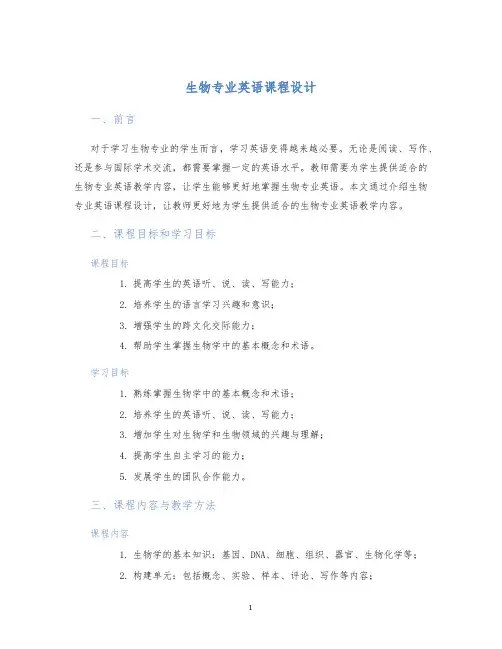
生物专业英语课程设计一、前言对于学习生物专业的学生而言,学习英语变得越来越必要。
无论是阅读、写作、还是参与国际学术交流,都需要掌握一定的英语水平。
教师需要为学生提供适合的生物专业英语教学内容,让学生能够更好地掌握生物专业英语。
本文通过介绍生物专业英语课程设计,让教师更好地为学生提供适合的生物专业英语教学内容。
二、课程目标和学习目标课程目标1.提高学生的英语听、说、读、写能力;2.培养学生的语言学习兴趣和意识;3.增强学生的跨文化交际能力;4.帮助学生掌握生物学中的基本概念和术语。
学习目标1.熟练掌握生物学中的基本概念和术语;2.培养学生的英语听、说、读、写能力;3.增加学生对生物学和生物领域的兴趣与理解;4.提高学生自主学习的能力;5.发展学生的团队合作能力。
三、课程内容与教学方法课程内容1.生物学的基本知识:基因、DNA、细胞、组织、器官、生物化学等;2.构建单元:包括概念、实验、样本、评论、写作等内容;3.实验室项目及报告:学生需要进行实验并撰写实验报告,以便更好地理解概念和实践应用;4.小组项目:该项目将涵盖生物领域的多个方面,包括分子生物学、遗传学、生态学和能量流动等。
学生需要在小组中合作完成项目,并在课堂上呈现项目结果;5.拓展阅读:通过阅读与生物学相关的文章或研究报告,对学生进行探究性的英语学习深入探讨。
教学方法1.讲述和讨论:信息的传达和介绍。
2.课堂练习和个人任务:学生个人的英语学习任务。
让学生有更多交互操作, 更深度的学习内容, 培养独立思考、自主管理的能力。
3.小组讨论和项目:交互学习、主动学习,创新思考, 培养团队协作能力。
4.实验和报告:快速、实用、直观。
5.拓展阅读:个性化学习,根据学生个人需要和目标,对英语学习进行深度拓展,增强其英文阅读和理解能力。
四、评价方式1.课堂表现 60%2.个人成果 10%3.实验报告 10%4.项目成果 20%五、参考文献1.Understanding Biology – Gary S. Pitts, PhD2.National Center for Biotechnology Information – NCBI3.Biochemistry, The Molecular Basis of Life – Trudy McKee,James R. McKee4.Nature – International weekly journal of science六、总结通过本文的生物专业英语课程设计,我们可以看出,学生的学习不仅仅在于单纯的英语语言学习,而且融会贯通各个生物科学领域,提高了学生对生物学知识的理解和掌握。
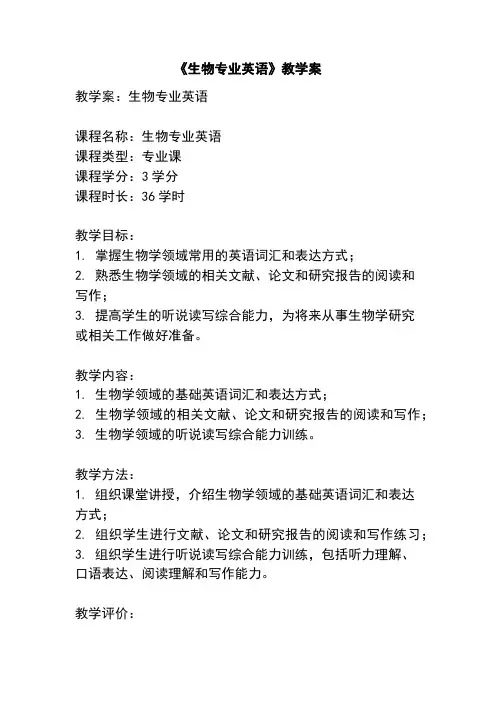
《生物专业英语》教学案教学案:生物专业英语课程名称:生物专业英语课程类型:专业课课程学分:3学分课程时长:36学时教学目标:1. 掌握生物学领域常用的英语词汇和表达方式;2. 熟悉生物学领域的相关文献、论文和研究报告的阅读和写作;3. 提高学生的听说读写综合能力,为将来从事生物学研究或相关工作做好准备。
教学内容:1. 生物学领域的基础英语词汇和表达方式;2. 生物学领域的相关文献、论文和研究报告的阅读和写作;3. 生物学领域的听说读写综合能力训练。
教学方法:1. 组织课堂讲授,介绍生物学领域的基础英语词汇和表达方式;2. 组织学生进行文献、论文和研究报告的阅读和写作练习;3. 组织学生进行听说读写综合能力训练,包括听力理解、口语表达、阅读理解和写作能力。
教学评价:1. 平时成绩占总评成绩的50%,包括课堂表现、作业完成情况等;2. 期末考试占总评成绩的50%,包括听力、口语、阅读和写作等方面的考核。
教学安排:第一周:介绍课程内容和教学目标,进行生物学领域的基础英语词汇和表达方式的讲解。
第二周:组织学生进行生物学领域文献、论文和研究报告的阅读练习,要求学生掌握阅读技巧和理解能力。
第三周:进行生物学领域听力训练,包括听取生物学相关讲座、演讲和讨论,并进行口语表达练习。
第四周:组织学生进行生物学领域的写作练习,包括摘要、实验报告和论文等的写作。
第五周:进行生物学领域的阅读理解练习,包括阅读和理解生物学相关文献和研究报告。
第六周:进行生物学领域的综合能力训练,包括听说读写的综合练习和模拟考试。
第七周:进行期末考试,包括听力、口语、阅读和写作等方面的考核。
第八周:总结课程内容和教学效果,进行学生评价和教师评价。
教学资源:1. 生物学领域的教材和参考书籍;2. 生物学领域的相关文献、论文和研究报告;3. 生物学领域的讲座、演讲和讨论录音或视频资料;4. 生物学领域的写作指南和范例;5. 听力、口语、阅读和写作练习题目和模拟试卷。
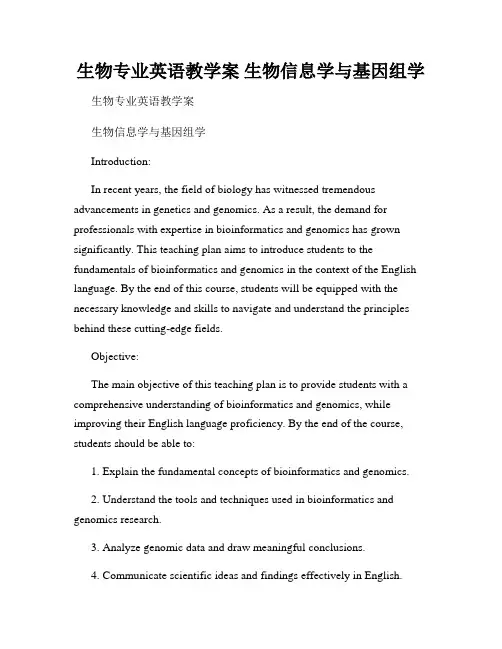
生物专业英语教学案生物信息学与基因组学生物专业英语教学案生物信息学与基因组学Introduction:In recent years, the field of biology has witnessed tremendous advancements in genetics and genomics. As a result, the demand for professionals with expertise in bioinformatics and genomics has grown significantly. This teaching plan aims to introduce students to the fundamentals of bioinformatics and genomics in the context of the English language. By the end of this course, students will be equipped with the necessary knowledge and skills to navigate and understand the principles behind these cutting-edge fields.Objective:The main objective of this teaching plan is to provide students with a comprehensive understanding of bioinformatics and genomics, while improving their English language proficiency. By the end of the course, students should be able to:1. Explain the fundamental concepts of bioinformatics and genomics.2. Understand the tools and techniques used in bioinformatics and genomics research.3. Analyze genomic data and draw meaningful conclusions.4. Communicate scientific ideas and findings effectively in English.Course Outline:1. Introduction to Bioinformatics and Genomics (Session 1-2)- Definition of bioinformatics and genomics.- Overview of the role of bioinformatics and genomics in modern biology.- Introduction to basic genetic concepts.2. Bioinformatics Tools and Databases (Session 3-4)- Introduction to bioinformatics tools and their applications.- Overview of major bioinformatics databases.- Hands-on exercises on using bioinformatics tools and databases.3. Genome Sequencing and Assembly (Session 5-6)- Introduction to DNA sequencing techniques.- Explanation of genome assembly methods.- Practical exercises on analyzing and assembling genomic data.4. Gene Expression Analysis (Session 7-8)- Overview of gene expression analysis techniques.- Introduction to microarrays and RNA sequencing.- Hands-on exercises on analyzing gene expression data.5. Comparative Genomics (Session 9-10)- Explanation of comparative genomics and its importance.- Comparative genomics tools and methods.- Case studies on comparative genomics analysis.6. Structural Genomics and Proteomics (Session 11-12)- Introduction to structural genomics and proteomics.- Overview of protein structure prediction methods.- Practical exercises on analyzing protein data and predicting structures.7. Application of Bioinformatics in Medicine (Session 13-14)- Explanation of how bioinformatics is used in medical research.- Case studies on the application of bioinformatics in disease analysis and drug discovery.8. Bioinformatics Ethics and Challenges (Session 15)- Discussion on ethical considerations in bioinformatics research.- Overview of challenges faced in the field.Assessment:1. Regular quizzes and assignments throughout the course to assess understanding of concepts.2. Final examination consisting of theoretical and practical components.3. Group projects to encourage teamwork and enhance communication skills.Conclusion:By following this teaching plan, students will not only gain a solid foundation in bioinformatics and genomics but also improve their English language proficiency. The combination of theoretical knowledge and practical exercises will equip students with the necessary skills to excel in the field of bioinformatics and genomics. With the rapid advancements in genetics and genomics, professionals with expertise in these fields will continue to be in high demand, making this course vital for those pursuing a career in biology.。
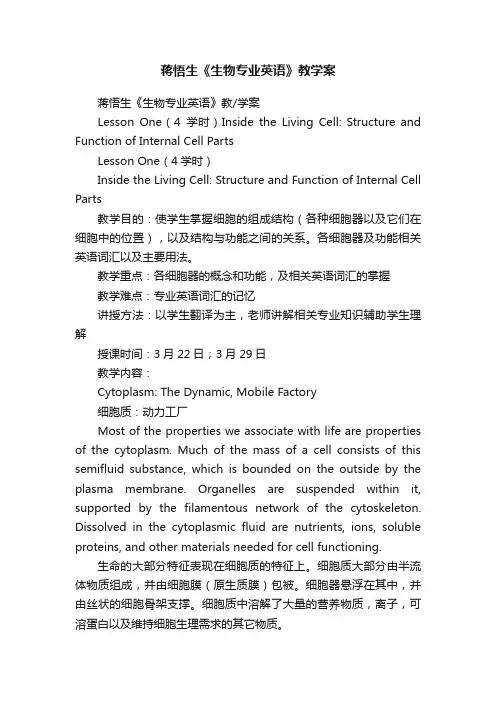
蒋悟生《生物专业英语》教学案蒋悟生《生物专业英语》教/学案Lesson One(4学时)Inside the Living Cell: Structure and Function of Internal Cell PartsLesson One(4学时)Inside the Living Cell: Structure and Function of Internal Cell Parts教学目的:使学生掌握细胞的组成结构(各种细胞器以及它们在细胞中的位置),以及结构与功能之间的关系。
各细胞器及功能相关英语词汇以及主要用法。
教学重点:各细胞器的概念和功能,及相关英语词汇的掌握教学难点:专业英语词汇的记忆讲授方法:以学生翻译为主,老师讲解相关专业知识辅助学生理解授课时间:3月22日;3月29日教学内容:Cytoplasm: The Dynamic, Mobile Factory细胞质:动力工厂Most of the properties we associate with life are properties of the cytoplasm. Much of the mass of a cell consists of this semifluid substance, which is bounded on the outside by the plasma membrane. Organelles are suspended within it, supported by the filamentous network of the cytoskeleton. Dissolved in the cytoplasmic fluid are nutrients, ions, soluble proteins, and other materials needed for cell functioning.生命的大部分特征表现在细胞质的特征上。
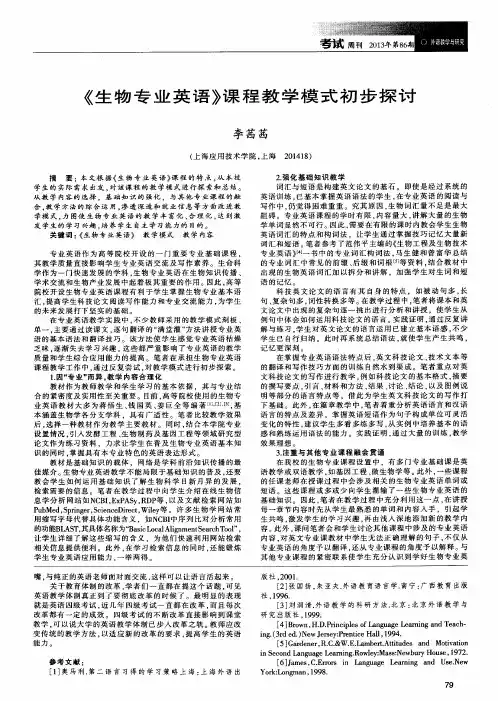
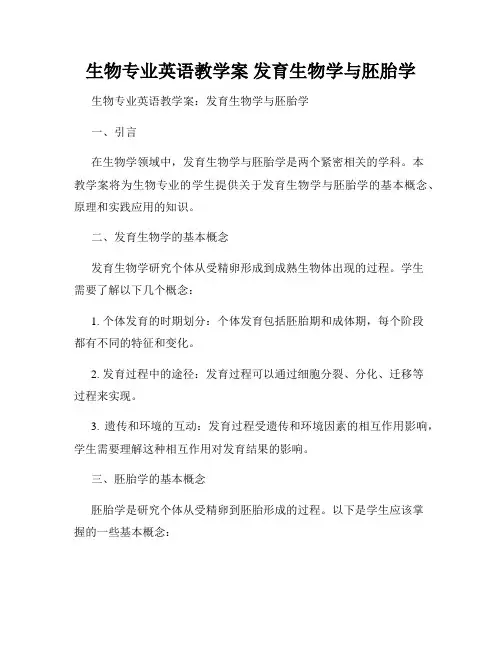
生物专业英语教学案发育生物学与胚胎学生物专业英语教学案:发育生物学与胚胎学一、引言在生物学领域中,发育生物学与胚胎学是两个紧密相关的学科。
本教学案将为生物专业的学生提供关于发育生物学与胚胎学的基本概念、原理和实践应用的知识。
二、发育生物学的基本概念发育生物学研究个体从受精卵形成到成熟生物体出现的过程。
学生需要了解以下几个概念:1. 个体发育的时期划分:个体发育包括胚胎期和成体期,每个阶段都有不同的特征和变化。
2. 发育过程中的途径:发育过程可以通过细胞分裂、分化、迁移等过程来实现。
3. 遗传和环境的互动:发育过程受遗传和环境因素的相互作用影响,学生需要理解这种相互作用对发育结果的影响。
三、胚胎学的基本概念胚胎学是研究个体从受精卵到胚胎形成的过程。
以下是学生应该掌握的一些基本概念:1. 受精:受精是卵子与精子结合形成受精卵的过程。
学生需要了解受精的基本原理和过程。
2. 胚胎形成:胚胎从受精卵开始发育,逐渐形成胚胎器官和组织。
这个过程是复杂且精确的,学生需要了解不同胚层的发育以及器官形成的机制。
3. 分期与分类:胚胎发育会经历不同的阶段,学生需要学会根据特定的标志对胚胎进行分类和分期。
四、发育生物学与胚胎学的实践应用发育生物学与胚胎学在多个领域有重要的应用,学生需要了解一些实践应用的例子,并理解其重要性:1. 医学应用:发育生物学与胚胎学在人类医学领域中起着关键作用,例如辅助生殖技术、胚胎筛查和基因治疗等。
学生可以了解这些应用的原理和方法。
2. 农业与畜牧业应用:发育生物学与胚胎学在农业和畜牧业中也有广泛的应用,例如人工授精、胚胎移植和遗传改良等。
学生需要了解这些应用对农业和畜牧业发展的意义。
3. 生物工程应用:发育生物学与胚胎学为生物工程领域的发展提供了基础。
学生需要了解一些生物工程技术,如基因编辑和克隆技术,以及其与发育生物学和胚胎学的关系。
五、结论发育生物学与胚胎学是生物学中重要的学科,对于了解个体发育的过程和机制具有重要意义。
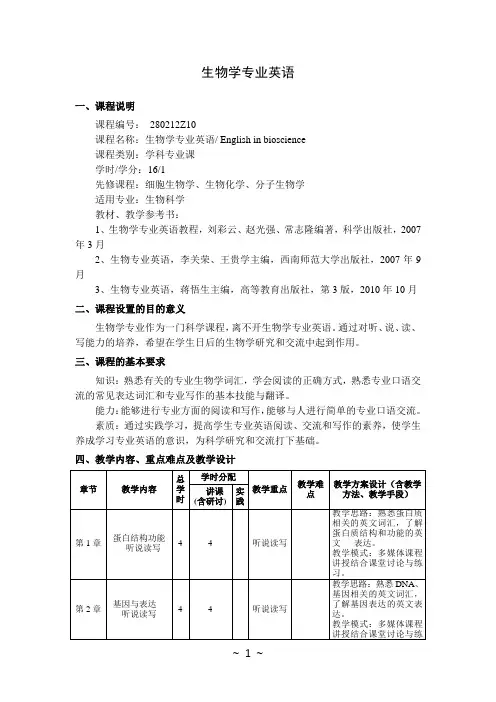
生物学专业英语
一、课程说明
课程编号:280212Z10
课程名称:生物学专业英语/ English in bioscience
课程类别:学科专业课
学时/学分:16/1
先修课程:细胞生物学、生物化学、分子生物学
适用专业:生物科学
教材、教学参考书:
1、生物学专业英语教程,刘彩云、赵光强、常志隆编著,科学出版社,2007年3月
2、生物专业英语,李关荣、王贵学主编,西南师范大学出版社,2007年9月
3、生物专业英语,蒋悟生主编,高等教育出版社,第3版,2010年10月
二、课程设置的目的意义
生物学专业作为一门科学课程,离不开生物学专业英语。
通过对听、说、读、写能力的培养,希望在学生日后的生物学研究和交流中起到作用。
三、课程的基本要求
知识:熟悉有关的专业生物学词汇,学会阅读的正确方式,熟悉专业口语交流的常见表达词汇和专业写作的基本技能与翻译。
能力:能够进行专业方面的阅读和写作,能够与人进行简单的专业口语交流。
素质:通过实践学习,提高学生专业英语阅读、交流和写作的素养,使学生养成学习专业英语的意识,为科学研究和交流打下基础。
四、教学内容、重点难点及教学设计
注:实践包括实验、上机等
五、实践教学内容和基本要求
学生参与(1)讲解分析有关专业课文或论文
(2)听力练习基本的生物学专业英语词汇
(3)生物学专业英语口语交流
(4)生物学专业英语写作与翻译。
六、考核方式及成绩评定
七、大纲主撰人:大纲审核人:。
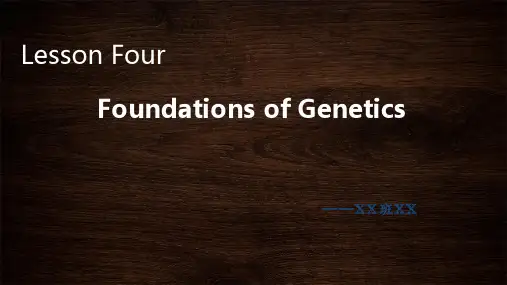
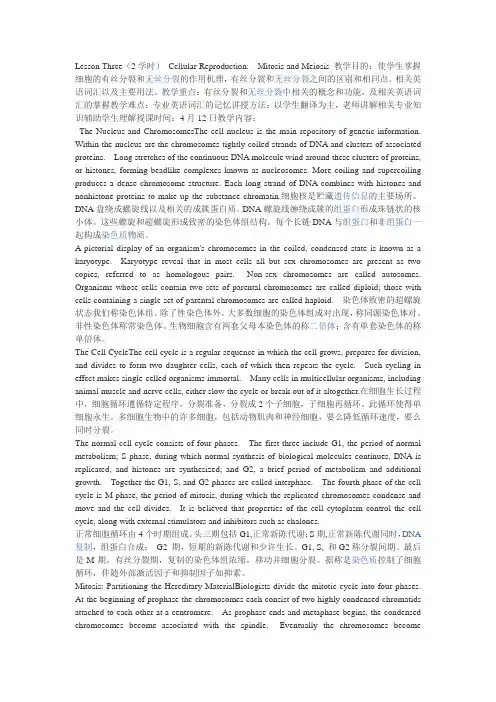
Lesson Three(2学时)Cellular Reproduction: Mitosis and Meiosis 教学目的:使学生掌握细胞的有丝分裂和无丝分裂的作用机理,有丝分裂和无丝分裂之间的区别和相同点。
相关英语词汇以及主要用法。
教学重点:有丝分裂和无丝分裂中相关的概念和功能,及相关英语词汇的掌握教学难点:专业英语词汇的记忆讲授方法:以学生翻译为主,老师讲解相关专业知识辅助学生理解授课时间:4月12日教学内容:The Nucleus and ChromosomesThe cell nucleus is the main repository of genetic information. Within the nucleus are the chromosomes tightly coiled strands of DNA and clusters of associated proteins. Long stretches of the continuous DNA molecule wind around these clusters of proteins, or histones, forming beadlike complexes known as nucleosomes. More coiling and supercoiling produces a dense chromosome structure. Each long strand of DNA combines with histones and nonhistone proteins to make up the substance chromatin.细胞核是贮藏遗传信息的主要场所。
DNA盘绕成螺旋线以及相关的成簇蛋白质。
DNA螺旋线缠绕成簇的组蛋白形成珠链状的核小体。
这些螺旋和超螺旋形成致密的染色体组结构。
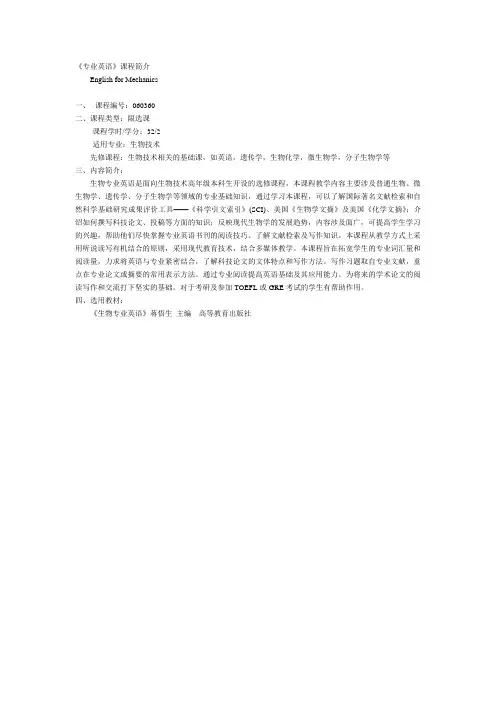
《专业英语》课程简介English for Mechanics一、课程编号:060360二、课程类型:限选课课程学时/学分:32/2适用专业:生物技术先修课程:生物技术相关的基础课,如英语,遗传学,生物化学,微生物学,分子生物学等三、内容简介:生物专业英语是面向生物技术高年级本科生开设的选修课程,本课程教学内容主要涉及普通生物、微生物学、遗传学、分子生物学等领域的专业基础知识,通过学习本课程,可以了解国际著名文献检索和自然科学基础研究成果评价工具——《科学引文索引》(SCI)、美国《生物学文摘》及美国《化学文摘》;介绍如何撰写科技论文、投稿等方面的知识;反映现代生物学的发展趋势,内容涉及面广,可提高学生学习的兴趣,帮助他们尽快掌握专业英语书刊的阅读技巧、了解文献检索及写作知识。
本课程从教学方式上采用听说读写有机结合的原则,采用现代教育技术,结合多媒体教学。
本课程旨在拓宽学生的专业词汇量和阅读量,力求将英语与专业紧密结合,了解科技论文的文体特点和写作方法。
写作习题取自专业文献,重点在专业论文或摘要的常用表示方法。
通过专业阅读提高英语基础及其应用能力。
为将来的学术论文的阅读写作和交流打下坚实的基础。
对于考研及参加TOEFL或GRE考试的学生有帮助作用。
四、选用教材:《生物专业英语》蒋悟生主编高等教育出版社《专业英语》课程教学大纲二、课程编号:060360二、课程类型:限选课课程学时:32适用专业:生物技术先修课程:生物技术相关的基础课,如英语,遗传学,生物化学,微生物学,分子生物学等。
三、课程性质与任务:生物专业英语是生物技术专业的限选课,通过学习本课程,可以了解国际著名文献检索和自然科学基础研究成果评价工具——《科学引文索引》(SCI)、美国《生物学文摘》及美国《化学文摘》;介绍如何撰写科技论文、投稿等方面的知识;反映现代生物学的发展趋势,内容涉及面广,可提高学生学习的兴趣,帮助他们尽快掌握专业英语书刊的阅读技巧、了解文献检索及写作知识。
山东理工大学教案(讨论稿)2006 ~ 2007 学年 第 二 学期生物专业英语 生物工程、生物技术、生命科学04级 孔 玲 生物技术与工程系《生物专业英语》蒋悟生编著 48/3生命科学学院课 程 名 称 授 课 对 象 主 讲 教 师教师所在院(部)、系(室) 选 用 教 材学 时 / 学 分教案编写说明教案是任课教师的教学实施方案。
任课教师应遵循专业教学计划制订的培养目标,以教学大纲为依据,在熟悉教材、了解学生的基础上,结合教学实践经验,提前编写设计好本门课程每次课的全部教学活动。
教案编写说明如下:1、教学课型表示所授课程的类型,请在理论课、实验课、习题课、实践课、技能课及其它栏内选择打“√”。
2、教学内容:是授课的核心。
将授课的内容按章、节或主题,有序的进行设计编排,并标以“*”和“#”符号以表示重点和难点。
3、教学方法和教学手段:教学方法指讲授、讨论、示教、指导等。
教学手段指板书、多媒体、网络、模型、标本、挂图、音像等教学工具。
4、讨论、思考题和作业:提出若干问题以供讨论,或作为课后复习时思考,亦可要求学生作为作业来完成,以供考核之用。
5、参考资料:列出参考书籍、有关资料。
6、首次开课的青年教师的教案应由导师审核。
7、鼓励教师在教学内容、教学方法和教学手段等方面进行创新与改革。
8、所有开课课程必须按此标准编写教案。
2山东理工大学教案3注:教师讲稿附后山东理工大学教案4注:教师讲稿附后山东理工大学教案5注:教师讲稿附后山东理工大学教案6注:教师讲稿附后山东理工大学教案7注:教师讲稿附后山东理工大学教案8注:教师讲稿附后山东理工大学教案9注:教师讲稿附后10山东理工大学教案11注:教师讲稿附后山东理工大学教案12注:教师讲稿附后山东理工大学教案13注:教师讲稿附后山东理工大学教案14注:教师讲稿附后山东理工大学教案15注:教师讲稿附后山东理工大学教案16注:教师讲稿附后17。
生物专业英语教学案一、教学背景生物专业英语课程是针对生物学专业学生开设的英语课程,旨在培养学生在生物领域中的英语表达能力和交流能力。
通过本课程的学习,学生将能够理解和运用生物学领域的专业术语、科技文献以及学术论文,提高其在国际生物学研究中的竞争力。
二、教学目标1.通过学习生物专业英语,学生将会了解和掌握生物学中的专业术语,能够准确描述生物学相关实验和研究。
2.培养学生阅读、理解和分析生物学文献的能力,能够理解和运用科技文献中的英语表达。
3.培养学生在学术交流和写作中的英语表达能力,提高学生在国际学术会议中的参与和演讲能力。
三、教学内容和方法1.专业术语学习:通过课堂讲解、课后阅读和小组讨论等方式,引导学生掌握生物学中的专业术语,并在实践中灵活运用。
2.科技文献阅读:通过分析和讨论科技文献,培养学生理解和分析生物学文献的能力,并通过写作和口头报告展示研究成果。
3.学术写作训练:通过给学生布置论文写作和报告写作任务,培养学生在学术写作中的英语表达能力,包括提纲撰写、引言撰写、方法和结果的描述等。
4.学术交流训练:通过模拟学术会议和小组讨论,培养学生学术交流和演讲的英语表达能力,加强学生的学术素养和自信心。
四、教学评价方法1.参与度评价:考察学生在课堂上的主动参与度、提问和讨论的积极性,通过课堂讨论、小组讨论和问答等形式进行评价。
2.作业评价:评估学生的作业完成情况,包括课后阅读、科技文献分析和论文写作等任务的完成情况和质量。
3.课堂测试评价:通过课堂测试考察学生对于专业术语的掌握程度和对科技文献的理解程度。
4.学术交流评价:通过模拟学术会议和小组讨论的方式进行评价,考察学生在学术交流和演讲中的英语表达能力。
五、教学资源和参考资料1.《生物学英语教程》(第二版),作者:杨春燕,出版社:清华大学出版社,年份:2018年。
2.《英语科技文献写作与翻译》(第二版),作者:王翠春,出版社:高等教育出版社,年份:2019年。
生物专业英语教学案生物技术与生物制药Title: Teaching Plan for Biotechnology and Biopharmaceuticals in Biological ScienceI. IntroductionBiotechnology and biopharmaceuticals are rapidly evolving fields within the realm of biological science. With the advancements in these fields, it is imperative to develop a comprehensive teaching plan that encompasses both theoretical knowledge and practical applications. This teaching plan aims to provide students with a solid foundation in the principles, techniques, and applications of biotechnology and biopharmaceuticals.II. ObjectivesThe objectives of this teaching plan are as follows:1. To familiarize students with the fundamentals of biotechnology and biopharmaceuticals.2. To introduce students to the various techniques and tools utilized in these fields.3. To cultivate critical thinking and problem-solving skills relevant to biotechnology and biopharmaceuticals.4. To expose students to real-world applications and industry practices.5. To enhance students' communication and collaborative skills through group projects and presentations.III. Curriculum Design1. Basic Conceptsa. Definition and scope of biotechnology and biopharmaceuticals.b. Historical development of the fields.c. Ethical considerations in biotechnology and biopharmaceutical industries.2. Principles of Biotechnologya. DNA structure and replication.b. Gene expression and regulation.c. Protein synthesis and modification.3. Techniques in Biotechnologya. DNA manipulation techniques (PCR, cloning, sequencing).b. Recombinant DNA technology.c. Immunological techniques (ELISA, Western blotting).d. Cell culture and transformation techniques.4. Biopharmaceuticalsa. Introduction to biopharmaceuticals.b. Production and purification of biopharmaceuticals.c. Types of biopharmaceuticals (recombinant proteins, monoclonal antibodies).d. Regulation and quality control in biopharmaceutical industries.5. Applications of Biotechnology and Biopharmaceuticalsa. Agricultural biotechnology (genetically modified crops, biopesticides).b. Medical biotechnology (gene therapy, personalized medicine).c. Industrial applications (biofuels, bioremediation).d. Current trends and future prospects in the field.IV. Teaching Strategies1. Lecture Sessionsa. Presenting key concepts and theories.b. Providing case studies and examples to illustrate practical applications.c. Encouraging student participation and discussion.2. Laboratory Exercisesa. Hands-on experience in DNA manipulation techniques.b. Culturing and transformation of cells.c. Protein expression and analysis techniques.d. Data analysis and interpretation.3. Group Projects and Presentationsa. Assigning group projects on selected topics.b. Encouraging independent research and critical analysis.c. Presenting findings and conclusions in a formal setting.4. Guest Lectures and Industry Visitsa. Inviting experts from biotechnology and biopharmaceutical industries.b. Organizing visits to research institutes and pharmaceutical companies.c. Providing students with exposure to real-world applications and opportunities.V. Assessment Methods1. Written Examinationsa. Assessing theoretical knowledge and understanding.b. Testing problem-solving abilities and critical thinking skills.2. Laboratory Reportsa. Evaluating practical skills and techniques.b. Analyzing experimental data and results.3. Group Project Evaluationa. Assessing research skills and teamwork abilities.b. Evaluating the quality of presentations and research findings.VI. ConclusionBy implementing this teaching plan for biotechnology and biopharmaceuticals, students will gain a well-rounded understanding of the subject matter. This comprehensive approach will equip them with the necessary knowledge and skills to succeed in the dynamic fields of biotechnology and biopharmaceuticals. Additionally, the incorporation of practical exercises, group projects, and industry exposure will further enhance their learning experience and prepare them for future career opportunities in these industries.。
《生物专业英语》教学大纲一、课程说明1、课程简介生物专业英语是面向生物科学、技术高年级本科生开设的限选课程,本课程教学内容主要涉及普通生物、微生物学、遗传学、分子生物学等领域的专业基础知识。
通过本课程,向学生介绍如何撰写科技论文、投稿等方面的知识;扩大专业英语的词汇量,掌握专业英语书刊的阅读技巧、了解文献检索及写作知识。
2、教学目的要求本课程是帮助已有一定英语基础的学生提高其阅读、翻译专业英语的能力。
旨在拓宽学生的专业词汇量和阅读量,力求将英语与专业紧密结合,了解科技论文的文体特点和写作方法,为将来的学术论文的阅读写作和交流打下坚实的基础。
3、教学重点难点本课程重点在于向学生介绍学科专业术语和概念,进一步提高阅读、理解英语专业文献的能力;重点讲解英译汉的技巧,培养对科技文献的理解能力,使同学熟练和逐步适应书面语体的特点和表达形式,能够准确、流畅的阅读、翻译生物技术英语文献,并能熟练的掌握英语工具,获取专业所需的信息,初步具备撰写科研论文的能力。
4、预修课程与后续课程本课程的先修课为大学英语,科技论文写作可作为后续课程。
大学英语的学习使学生掌握了一定的英语词汇和语法,专业英语则是重点提高专业英语的词汇量,掌握专业英语文献的阅读技巧、了解文献检索及写作知识;是今后学术论文撰写的必需前提。
5、教学手段及教学方法建议本课程采用自学与讲授相结合,理论与实践相结合的教学方法。
教学中突出以学生作为主体,运用多媒体等教学手段对其进行专业英语的学习指导。
同时为了提高学生英语听说读写的基础能力,可采取小组讨论式等灵活多样的教学形式,调动其学习积极性。
6、考核方式本课程为考查课,期末开卷考试。
总成绩满分一百分,包括平时成绩占20%+期末考试成绩80%。
7、指定教材蒋悟生主编,生物专业英语(第二版),高等教育出版社,2000年。
8、教学参考书[1] 邬行彦等编,生物工程、生物技术专业英语(第一版),化学工业出版社,2002年。
生物专业英语教学案人体解剖学与生理学Title: Teaching Plan for Biological Major: Human Anatomy and PhysiologyWord Count: 1500 words (subject to slight variation)Introduction:In the field of biology, the study of human anatomy and physiology is of utmost importance. This teaching plan aims to provide a comprehensive approach to teaching these subjects in an English-speaking classroom. By incorporating effective teaching strategies, engaging activities, and relevant resources, students will gain a solid understanding of the intricacies of the human body.1. Course Objectives1.1 To develop a basic understanding of human anatomy and physiology.1.2 To enhance students' English language skills in the context of biological sciences.1.3 To foster critical thinking and analytical abilities through the study of anatomical structures and physiological processes.2. Teaching Methodologies2.1 Interactive Lectures: Using multimedia presentations to introduce key concepts, structures, and functions.2.2 Practical Demonstrations: Conducting hands-on activities to reinforce theoretical knowledge.2.3 Group Discussions: Encouraging students to actively participate and share their perspectives.2.4 Case Studies: Presenting real-life scenarios to apply learned knowledge to practical situations.2.5 Problem-solving Exercises: Engaging students in critical thinking tasks related to human anatomy and physiology.3. Course Contents3.1 Introduction to Human Anatomy and Physiology- Terminology, anatomical planes, body cavities, and systems.3.2 Skeletal System- Structure, function, and common disorders.3.3 Muscular System- Types of muscles, muscle contraction, and movement.3.4 Digestive System- Organs, processes of digestion, and nutrient absorption.3.5 Respiratory System- Breathing mechanisms, gas exchange, and respiratory disorders.3.6 Cardiovascular System- Heart structure, blood circulation, and common cardiovascular diseases.3.7 Nervous System- Neurons, brain regions, sensory and motor functions.3.8 Endocrine System- Major endocrine glands, hormones, and their role in homeostasis.3.9 Reproductive System- Male and female reproductive anatomy, menstrual cycle, and human developmental stages.4. Assessment Methods4.1 Quizzes and Examinations: Regular assessments to evaluate students' understanding.4.2 Research Projects: Conducting independent research on specific anatomical or physiological topics.4.3 Practical Lab Assessments: Evaluating students' practical skills in identifying anatomical structures.4.4 Class Participation: Encouraging active involvement in discussions and activities.5. Resources and References5.1 Textbooks: "Human Anatomy and Physiology" by Elaine N. Marieb.5.2 Websites: "InnerBody" and "Virtual Anatomy Lab" for interactive virtual dissection.5.3 Visual Aids: Anatomical models, charts, and diagrams for visual representation.5.4 Videos: Educational videos illustrating anatomical structures, physiological processes, and clinical applications.Conclusion:By implementing this teaching plan for human anatomy and physiology in the context of English language learning, students will be equipped with fundamental knowledge of the human body and related English language skills. Through interactive lectures, practical demonstrations, and various assessments, students will develop a deep understanding of the complexities of human anatomy and physiology, enabling them to pursue further studies and careers in the field of biology.。
生物专业英语教学案生化技术与基因编辑一、引言在当今生物科技的迅速发展中,生化技术与基因编辑成为了生物专业非常重要的课题。
本文将介绍生化技术与基因编辑的基本概念、重要应用以及对教学实施的建议。
二、生化技术概述生化技术是通过应用化学和生物学原理来研究和改良生物体的技术。
它主要包括分子生物学、克隆技术、生物传感器等方面的内容。
生化技术既可以在基础研究中进行应用,也可以广泛应用于医药、农业、环境保护等领域。
三、基因编辑的基本原理基因编辑是指通过特定的技术手段对生物体的基因组进行精确的修改。
其中最常用的技术是CRISPR-Cas9系统。
该系统利用CRISPR引导RNA的导引作用,将Cas9蛋白引向目标基因组的特定位置,并通过Cas9蛋白的核酸酶活性切割DNA链,从而实现对基因组的定点改变。
四、基因编辑的应用1. 疾病研究与治疗通过基因编辑技术,科学家可以模拟人类疾病的发生机制,并开展相关的研究。
同时,基因编辑也为疾病的治疗提供了新的方法。
例如,通过基因编辑修复携带有疾病基因的干细胞,为疾病的治疗提供了新的可能性。
2. 农业改良基因编辑技术可以被应用于作物的改良,提高作物的抗病性、产量以及营养价值。
通过精确改变作物的基因组,农作物的品质和产量可以得到显著提升,为粮食安全和农业的可持续发展提供了新途径。
3. 动物模型研究基因编辑技术在动物模型的构建上也发挥了重要作用。
科学家可以通过基因编辑技术改变特定基因的表达,制作出适合研究特定疾病或生理过程的动物模型,有助于揭示疾病发生的机制以及开发相关治疗方法。
五、生化技术与基因编辑的教学实施建议1. 深入理论知识在教学中,首先应当对生化技术与基因编辑的基本原理和相关技术进行深入的讲解,使学生了解其背后的科学原理和应用价值。
2. 实验操作培训为了加强学生的实践操作能力,可以进行相关实验操作培训。
通过操作实验,学生可以更好地掌握生化技术与基因编辑的操作流程和技巧。
3. 理论与应用结合教学中应当注重理论知识与实际应用的结合。
蒋悟生《生物专业英语》教/学案Lesson One(4学时)Inside the Living Cell: Structure and Function of Internal Cell PartsLesson One(4学时)Inside the Living Cell: Structure and Function of Internal Cell Parts教学目的:使学生掌握细胞的组成结构(各种细胞器以及它们在细胞中的位置),以及结构与功能之间的关系。
各细胞器及功能相关英语词汇以及主要用法。
教学重点:各细胞器的概念和功能,及相关英语词汇的掌握教学难点:专业英语词汇的记忆讲授方法:以学生翻译为主,老师讲解相关专业知识辅助学生理解授课时间:3月22日;3月29日教学内容:Cytoplasm: The Dynamic, Mobile Factory细胞质:动力工厂Most of the properties we associate with life are properties of the cytoplasm. Much of the mass of a cell consists of this semifluid substance, which is bounded on the outside by the plasma membrane. Organelles are suspended within it, supported by the filamentous network of the cytoskeleton. Dissolved in the cytoplasmic fluid are nutrients, ions, soluble proteins, and other materials needed for cell functioning.生命的大部分特征表现在细胞质的特征上。
细胞质大部分由半流体物质组成,并由细胞膜(原生质膜)包被。
细胞器悬浮在其中,并由丝状的细胞骨架支撑。
细胞质中溶解了大量的营养物质,离子,可溶蛋白以及维持细胞生理需求的其它物质。
The Nucleus: Information Central(细胞核:信息中心)The eukaryotic cell nucleus is the largest organelle and houses the genetic material (DNA) on chromosomes. (In prokaryotes the hereditary material is found in the nucleoid.) The nucleus also contains one or two organelles-the nucleoli-that play a role in cell division. A pore-perforated sac called the nuclear envelope separates the nucleus and its contents from the cytoplasm. Small molecules can pass through the nuclear envelope, but larger molecules such as mRNA and ribosomes must enter and exit via the pores.真核细胞的细胞核是最大的细胞器,细胞核对染色体组有保护作用(原核细胞的遗传物质存在于拟核中)。
细胞核含有一或二个核仁,核仁促进细胞分裂。
核膜贯穿许多小孔,小分子可以自由通过核膜,而象mRNA 和核糖体等大分子必须通过核孔运输。
Organelles: Specialized Work Units(细胞器:特殊的功能单位)All eukaryotic cells contain most of the various kinds of organelles, and each organelle performs a specialized function in the cell. Organelles described in this section include ribosomes, the endoplasmic reticulum, the Golgi complex, vacuoles, lysosomes, mitochondria, and the plastids of plant cells.所有的真核细胞都含有多种细胞器,每个细胞器都有其特定功能。
本节主要介绍核糖体,内质网,高尔基体系,液泡,溶酶体,线粒体和植物细胞中的质体。
The number of ribosomes within a cell may range from a few hundred to many thousands. This quantity reflects the fact that, ribosomes are the sites at which amino acids are assembled into proteins for export or for use in cell processes. A complete ribosome is composed of one larger and one smaller subunit. During protein synthesis the two subunits move along a strand of mRNA, "reading" the genetic sequence coded in it and translating that sequence into protein. Several ribosomes may become attached to a single mRNA strand; such a combination is called a polysome. Most cellular proteins are manufactured on ribosomes in the cytoplasm. Exportable proteins and membrane proteins are usually made in association with the endoplasmic reticulum.核糖体的数量变化从几百到几千,核糖体是氨基酸组装成蛋白质的重要场所。
完整的核糖体由大亚基和小亚基组成。
核糖体沿着mRNA移动并阅读遗传密码,翻译成蛋白质。
一条mRNA上可能有多个核糖体,称多聚核糖体。
大多数细胞蛋白是由细胞质中核糖体生产。
输出蛋白和膜蛋白通常与内质网有关。
The endoplasmic reticulum, a lacy array of membranous sacs, tubules, and vesicles, may be either rough (RER) or smooth (SER). Both types play roles in the synthesis and transport of proteins. The RER, which is studded with polysomes, also seems to be the source of the nuclear envelope after a cell divides.内质网,带有花边的生物囊,有管状,泡状之分,以及光滑和粗糙面区别。
两种都与蛋白质的合成和运输有关。
粗糙内质网上分布许多核糖体,也可能提供细胞分裂后所需的细胞膜。
SER lacks polysomes; it is active in the synthesis of fats and steroids and in the oxidation of toxic substances in the cell. Both types of endoplasmic reticulum serve as compartments within the cell where specific products can be isolated and subsequently shunted to particular areas in or outside the cell.光滑内质网上无核糖体,主要作用是脂肪和类固醇的合成以及细胞内有毒物质的氧化。
两种内质网合成的产物在其中进行分流或运输到细胞外。
Transport vesicles may carry exportable molecules from the endoplasmic reticulum to another membranous organelle, the Golgi complex. Within the Golgi complex molecules are modified and packaged for export out of the cell or for delivery else where in the cytoplasm.运输小泡能够将可运输分子从内质网运输到高尔基复合体上。
在高尔基复合体中修饰,包装后输出细胞或传递到细胞质中的其他场所。
Vacuoles in cells appear to be hollow sacs but are actually filled with fluid and soluble molecules. The most prominent vacuoles appear in plant cells and serve as water reservoirs and storage sites for sugars and other molecules. Vacuoles in animal cells carry out phagocytosis (the intake of particulate matter) and pinocytosis (vacuolar drinking).细胞中的液泡好象是中空的,但实际上充满了液体和可溶分子。
最典型的液泡存在于植物细胞中,储备水,糖以及其它分子。
动物中的液泡起吞噬和胞饮作用。
A subset of vacuoles are the organelles known as lysosomes, which contain digestive enzymes (packaged in lysosomes in the Golgi complex) that can break down most biological macromolecules. They act to digest food particles and to degrade damaged cell parts.溶酶体是液泡亚单位,含有消化酶,降解大部分生物大分子。